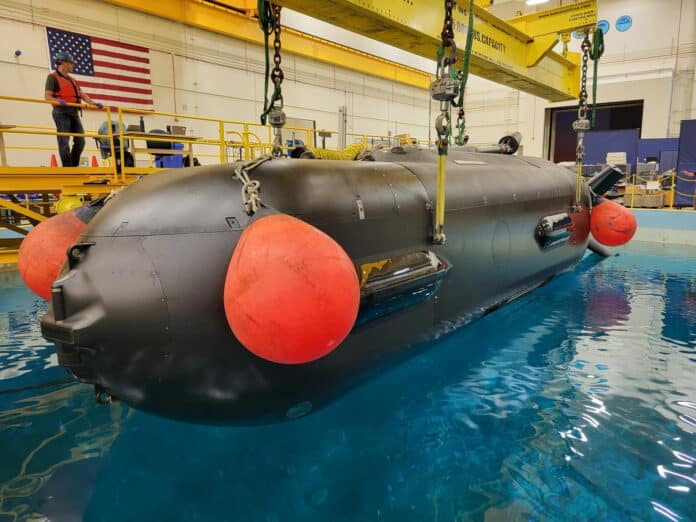Boeing has delivered the first Orca Extra Large Uncrewed Undersea Vehicle (XLUUV) to the U.S. Navy following acceptance testing completion this month. The delivery of the autonomous submarine was delayed by several years due to differences between Orca and its prototype, as well as the COVID-19 pandemic.
The XLUUV, also known as “Orca,” is a cutting-edge autonomous submarine that can perform long-duration critical missions to achieve undersea maritime dominance in changing environments and contested waters.
With the partnership of the Navy, the submarine drone has previously undergone several phases of at-sea testing, including maneuvering above and below the surface to demonstrate the vehicles’ unique capabilities. Boeing is expected to deliver four more Orcas to the Navy, with the last one set to be handed over in June 2024.
Orca, a fully autonomous uncrewed underwater vehicle (UUV) with a large payload capacity, is the result of more than a decade of pioneering work by Boeing. The vehicle is based on an earlier private venture called Echo Voyager, which was an evolution of previous UUV concepts, Echo Seeker and Echo Ranger, and was first designed and developed in 2012.
In 2017, Boeing was awarded development contracts for XLUUVs by the Navy alongside Lockheed Martin. Boeing received a $43 million deal to build four Orcas in partnership with Huntington Ingalls Industries in February 2019. A fifth Orca was added to the order the following month.
The Orca, weighing 80 tons and measuring 85 feet long, is designed to be highly modular to accommodate different mission requirements for the Navy. Its core vehicle offers different functions such as guidance and control, navigation, autonomy, situational awareness, core communications, power distribution, propulsion and maneuvering, as well as mission sensors.
It also comes with an extendable mast and a 34-foot-long payload section that can support up to eight tons of payload capacity. The Navy primarily plans to use this space to dispense mines.
They also hope that Orca’s modular payload section can accommodate other payloads to undertake different missions, such as minesweeping missions, electronic warfare, and undersea surveillance. Future payloads are expected to include synthetic aperture sonar to allow Orca to map the ocean floor. Additionally, the Navy is interested in arming its XLUUVs with additional weapons systems, including torpedoes, cruise missiles, and even aerial drones.
Orca is propelled using a hybrid diesel-electric propulsion system that enhances its utility for the Navy. This allows it to stay submerged for long periods of time and move underwater silently. With its diesel-electric engine and lithium-ion batteries, Orca should be able to remain at sea for months while cruising at around 3 knots (5.6 km/h). Its shrouded propulsor, instead of a conventional propeller, also adds to its ability to move efficiently and quietly.
Due to its size, it remains unclear how exactly the Navy would deploy such a large drone. But potential options include using large surface ships and piers, while another possibility is using the Navy’s existing Expeditionary Sea Bases (ESBs).
Regardless of the deployment method, Orca would allow the Navy to operate silently over long periods of time and across wide regions, making it a valuable resource in various situations. For example, it could be used to target enemy shipyards and ports or for high-risk operations like laying mines in narrow waterways such as rivers.
“This is the culmination of more than a decade of pioneering work, developing a long-range, fully autonomous undersea vehicle with a large payload capacity that can operate completely independently of a host vehicle,” said Ann Stevens, Boeing Maritime and Intelligence Systems vice president. “I’ve had the distinct pleasure of witnessing our team bring this first-of-its-kind capability to life, and I’m proud of their innovation, perseverance, and unwavering commitment, which has yielded the most advanced and capable UUV in the world. With the Navy’s partnership, we look forward to continuing to deliver this game-changing vehicle to the fleet.”
